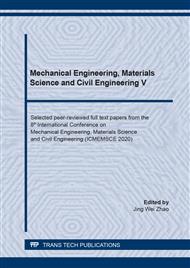[1]
Q. Zou, H. Ning, Z. Shen et al, Effects of AlB2/AlP phase and electromagnetic stirring on impurity B/P removal in the solidification process of Al-30Si alloy, Separation & Purification Technology. 207(2018) 151-157.
DOI: 10.1016/j.seppur.2018.06.052
Google Scholar
[2]
S. Liu, Z. W. Fang, L.X. Li, Tribological Characteristics of Submicron SiC(p)-GR(p)/Zn-35Al-1Mg Composites in Semisolidification Casting process, IOP Conference Series Materials Science and Engineering. 359(2018) 012049.
DOI: 10.1088/1757-899x/359/1/012049
Google Scholar
[3]
C. A. Gandin,M. Rappaz, A coupled finite element-cellular automaton model for the prediction of dendritic grain structure in solidification process, Acta Metall, Mater. 42(1994) 2233-2246.
DOI: 10.1016/0956-7151(94)90302-6
Google Scholar
[4]
Y. Z. Lu, Y. Xiong, J.Q. Peng et al, Simulation and Experiment of Solidification Process for Directionally Solidified Industrial Gas Turbine Hollow Blades, Journal of Materials Engineering. 46(2018) 8-15.
Google Scholar
[5]
C. A. Gandin, J. L. Desbiolles, M. Rappaz et al, A three-dimensional cellular automaton finite element model for the prediction of solidification grain structures. Metallurgy and Materials Transactions A. 30(1999) 3153-31604.
DOI: 10.1007/s11661-999-0226-2
Google Scholar
[6]
Z.P. Guo ,S.M. Xiong, Effects of alloy materials and process parameters on the heat transfer coefficient at metal/die interface in high pressure die casting, Acta Metallurgica Sinica. 44 (2008) 433-439.
Google Scholar
[7]
H. Y. Li, W. G. Chen, F. Q. Zhang et al, Evolution of wire'+arc additive manufactured titanium alloy during solidification process based on CAFE simulation, The Chinese Journal of Nonferrous Metals. 28(2018)1775-1783.
Google Scholar
[8]
A.Pineau, G.Guillemot, G.Reinhart et al, Three-dimensional cellular automaton modeling of silicon crystallization with grains in twin relationships, Acta Materialia.191(2020)230-244.
DOI: 10.1016/j.actamat.2020.03.051
Google Scholar
[9]
T.Zeng, K.Shi, Shukur et al, Modeling of poly-crystalline silicon ingot crystallization during casting and theoretical suggestion for ingot quality improvement, Materials science in semiconductor processing. 53(2016) 36-46.
DOI: 10.1016/j.mssp.2016.05.013
Google Scholar
[10]
M. Rappaz, C. A. Gandin, Probabilistic Modeling of Microstructure Formation in Solidification Processes, Acte Metall.41(1993) 345-360.
DOI: 10.1016/0956-7151(93)90065-z
Google Scholar
[11]
L.T. He,Design and optimization of casting process for A356 aluminum alloy thin-wall frame casting, Inner Mongolia University of Technology.(2019).
Google Scholar


